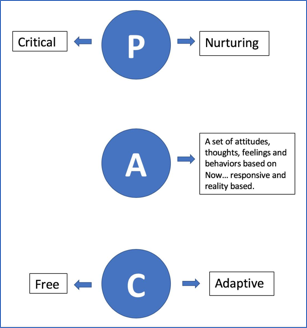Time to Grow Up: Adulting Mindfully

By Fleet Maull, guest contributor
We often associate being an adult with burdens and unwelcome responsibility. Perhaps some part of us longs for a Peter Pan life, where we imagine we would be happier if we never had to grow up and deal with the challenges of living life as an adult. Most of us know only too well that a Peter Pan life strategy is actually a prescription for suffering. Nonetheless, truly embracing true adulthood is another matter. Transactional Analysis offers a very helpful framework known as Parent – Adult – Child, which can be understood as ego states, mindsets, psychological positions or personas. We could also call these contexts. We can experience ourselves and react or respond to the world around us through the context or lens of any of these three psychological positions. In my training work, we say the Adult is a set of attitudes, thoughts, feelings, and behaviors grounded in the present moment, based on an objective assessment of what is actually happening right now.
The Parent and Child ego states, on the other hand, are based on the past, mostly on early childhood conditioning. The Parent represents the download of conditioning or psychological programming we received in early childhood from our parents and/or other adult authority figures and has two forms: a) the healthy, nurturing, protective Parent and b) the less healthy, judgmental, critical, controlling, dominating Parent. While we all hope that every child would receive the healthy, nurturing, protective parent energy in appropriate ways; between adults, it is another matter. There is certainly a place for mentoring or nurturing between adults; however, the nurturing/protective Parent can become a psychological rescuer and manifest as false altruism or what my first meditation teacher called idiot compassion. This can actually be demeaning and disempowering and being a rescuer or engaging in false altruism is really all about us, not the other person. The other person is just a vehicle for building up our own ego in this case.
The Child represents all of the adaptations and strategies we came up with as children to survive in an often emotionally unsafe world dominated by our parents or other authority figures. This takes the form of the needy, adaptive (in the negative co-dependent sense), controlling, manipulative, tantrum-throwing child. We may copy some of these characteristics modeled by older siblings as well.
There is also a healthy Child. This is the free and natural, wise- innocent, playful Child. The healthy Child, when accessed by the Adult, is the source of creativity, joy, fun and spiritual openness in life. Clearly, there is a difference between being childlike and childish. Many of us need to learn out to re-access our natural, wise innocent child from an integrated Adult. One way to quickly become aware of where the unhealthy or dysfunctional child energy is showing up in our lives is to look at the parts of our lives that are messy, unattended to or where we are irresponsible… whether that might be our health, our relationships, our finances, our eating habits, addictions, our home, closets, car, garage, etc. Can we honestly look to see in which dimensions of our life we are letting the Child running the show? I sure sign of Child energy is wanting to have our cake and eat it too and not being able to make choices or keep commitments. The Child has no relationship with death and wants to keep all options on the table at all times. The Adult is willing to choose, to experience the loss involved in making a choice and committing to a course of action. Adults can also own the consequences and impacts of their choices and behaviors.
Parent – Adult - Child

The practice of mindfulness allows us to access the Adult state and stabilize our locus of decision making and relating with others in an integrated Adult state, free of unconscious and unintegrated archaic influences from early childhood. This allows us to show up in life, take ownership for choices and keep commitments. There is significant current neurobiological evidence demonstrating that regular mindfulness practice increases our capacity for cognitive control and emotional balance. It improves our ability to self-regulate our own physiological and emotional reactions and response. Mindfulness supports living in a relational-responsive rather than survival-reactive mode.2
When we become triggered physiologically and emotionally into some degree of fight or flight, old tapes start playing. Our internalized Parent and/or Adaptive Child kicks in, and we reactively engage in relationships playing out the ghosts of our past, old fear- and survival-based habitual patterns and strategies inherited from our parents and other early authority figures or ones we developed as young children in order to survive. With regular mindfulness practice, we develop the awareness that allows us to recognize the physiology of triggering and the signs of old patterns arising, such that we can make use of self-regulation techniques like simply taking a deep breath, counting to ten, straw breathing or other breath regulation techniques to become un-triggered, to release the grip of the reptilian brain fight or flight reaction and return to the Adult. Having re-established ourselves in the Adult state of being, we can make a reasonable assessment of the situation and respond in the best way possible… or at least – not react in unskillful and even harmful way.
Straw Breathing Exercise: Try this simple self-regulation technique, which directly activates the relaxation response or the parasympathetic branch of the autonomic nervous system, the next time you feel emotionally triggered, anxious or stressed out. Consciously shift to diaphragmatic or “belly” breathing. Begin breathing in through the nose (with mouth closed) and out through pursed lips, as if you are breathing out through a straw (you can use an actual straw if you like for the out-breath only). Now begin counting with your inhalations and exhalations, breathing in for perhaps a 4 or 5 counts and out for an 8 or 10 count. The idea is to extend the time of the exhalation to be twice as long, or at least 50% longer than the inhalation. Continue breathing this way until you notice the calming effect on your physiological, mental and emotional state.
We all know that we are much more triggerable and reactive when we are tired and depleted. If we overindulge in caffeine, alcohol, sugar, junk food, etc. and do not take care of ourselves, we are very prone to fear- and survival-based reactivity. The answer is cultivating resilience. Becoming more physically, mentally, emotionally and spiritually fit and resilient is the key to living our life from the Adult. We can increase resilience in all the common sense ways of taking care of ourselves physically, mentally, emotionally and spiritually. Regular mindfulness practice enhance or leverages all of our self-care practices to develop a deep reservoir of resilience, such that it takes a lot more to trigger us out of the Adult into some pattern of reactivity and we are able to recover much more quickly, releasing triggers to return to the Adult.
To be effective, mindful leaders, the kinds of leaders our world desperately needs more than ever, we need be stabilized in our Adult and have the resilience to operate from the responsive-relational mode even in the face of very significant challenges. When triggered emotionally, we need to be able to recover quickly and access the present-focused, responsive part of our brain in order to bring our best self, experience, and wisdom to our role and engagement with others as mindful leaders.
Taking an embodied approach to mindfulness practice further enhances resilience. Our entire body is sensory. All of our internal tissues are sensory. We have a capacity known as interoception or interoceptive awareness. This is the body’s capacity to feel itself from the inside out, so to speak. We are all familiar with interoception, as this is how we know when we are thirsty, hungry, tired, or need to use the restroom. Experiencing muscle or joint pain, indigestion or a headache are all examples of the function interoception. Our interoceptive awareness is commonly only activated when we experience some pain or discomfort, or on the other hand, physical pleasure. By taking an embodied approach to mindfulness practice, we can develop a more abiding interoceptive awareness that translates into feeling present, grounded… embodied. Developing the capacity to remain more anchored in a deeply felt, embodied presence in the midst of our dialing activities, not only gives us more access to the Adult but contributes significantly to well-being and resilience. Others will also experience us as more present and available as well. In fact, research in the emerging field interpersonal neurobiology points to the connection between this interoceptive awareness and our ability to tune into and connect with others. Interoceptive awareness is connected with our capacity for empathic resonance and intimacy with others.3,4
While having a body means we are certainly going to experience discomfort and pain at the time, our bodies are actually wired for joy and bliss. In fact, the more we can embrace the totality of our physical and emotional embodied experience as Adults and deepen our capacity of abiding interoceptive awareness, the more access we have the moment-to-moment experience of the joy and bliss of felt aliveness and presence. In the present moment, life is fairly simple. It only gets complicated when we project ourselves into the past or future or allow ourselves to be swept away by fear- and survival-based reactivity. Simple, ordinary, moment-to-moment, embodied presence has always been the ground of the mystical awareness and ineffable joy experienced by saints and sages, and ordinary mindful leaders and practitioners like us. There is considerable evidence that regular mindfulness practice can make a significant contribution to our ability to lead with resilience, joy, and wisdom… transmitting the joy of living and being to everyone we encounter.
Fleet Maull, Ph.D. is renowned author, teacher, and founder and training director of Prison Mindfulness Institute, Engaged Mindfulness Institute, Center for Mindfulness in Public Safety, and Windhorse Seminars & Consulting.
Notes
- Clarkson, P., & Gilbert, M. (1988). Berne’s Original Model of Ego States: Some Theoretical Considerations. Transactional Analysis Journal, 18(1), 20–29. https://doi.org/10.1177/036215378801800105
- Goleman, D. & Davidson, R. (2017). Altered Traits: Science Reveals How Meditation Changes Your Mind, Brain, and Body. New York, NY: Penguin Random House
- Siegel, D. (2010) Mindsight: The New Science of Personal Transformation. New York, NY: Random House
- Siegel, D. (2016). Mind: A Journey to the Heart of Being Human. New York, NY: W.W. Norton & Company

0 comments
Leave a comment